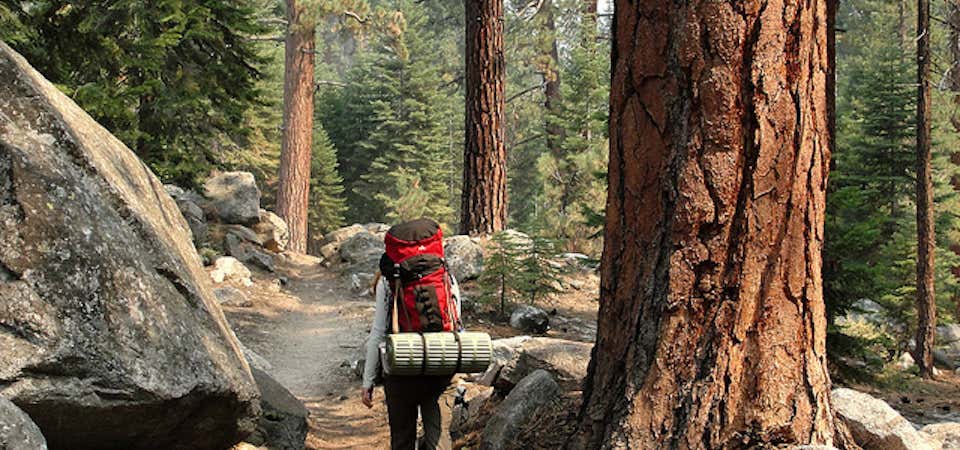If you're an avid hiker, or you're a fan of one Ms. Reese Witherspoon, then you've probably dreamed of hiking the Pacific Crest Trail. And if you don't know a lot about it, get ready to add it to your bucket list, because it's an incredible, once-in-a-lifetime experience. The Pacific Crest Trail (or the PCT to those hip to the lingo) runs up the Pacific Coast, from Mexico to Canada. That's 2,663 miles of America's most breathtaking landscapes (sorry, Appalachian trail!) If you conquer the whole thing, you'll pass through 7 National Parks, 25 National Forests, and countless other state parks, designated wilderness areas, National Monuments, and tons more.
1
Anza-Borrego Desert State Park
This is America's second-largest state park, protecting a massive tract of the Colorado Desert in southern California. It's most famous for its explosion of colorful desert wildflowers in the spring, and for its endless night skies, perfect for stargazing, even without a telescope.
2
Vasquez Rocks Natural Area Park
If you're looking to add a little something extra to your epic Pacific Crest Trail hike, then take a breather at the Vasquez Rocks Natural Area, which is along the route. If you want to add some rock scrambling to your trip, this is a great place to go for it: the sandstone formations here are out of this world. In fact, they're so Martian-looking that they've been used as a filming location for numerous TV shows and movies... like Star Trek! :)
3
Kings Canyon National Park
At the edge of the Sierra Nevada Mountains lies Kings Canyon National Park. Bordering Sequoia National Park, Kings Canyon is rugged and remote landscape filled with lakes, forests, and archaeological and historic sites to explore.
4
Devils Postpile National Monument
Looking up at the bizarre, twisting columns that make up Devils Postpile National Monument, it's hard to imagine how they were formed... and it's even weirder when you consider that the stone formations came from a boiling lake of red-hot lava. The slow-moving flow, which dammed up right where the monument is located, eventually cooled and contracted, forming the unusual columnar basalt formations that we see today. Glaciers scraped away parts of the basalt, revealing the pile of massive columns. On average, the columns are two feet wide and can be over 60 feet tall. Most are 6-sided, but you can also find 5-sided, 4-sided, and even 30-sided stones-- this is due to the fact that the lava cooled unevenly and rapidly.
Climbing to the top of Devils Postpile offers gorgeous views of the California landscape, including the lovely High Sierras. The massive, 101-foot-tall Rainbow Falls is also protected by the National Monument designation-- it got its enchanting name from the fact that rainbows constantly form in the mist off the churning water. Devils Postpile is also located with the Ansel Adams Wilderness, near the Inyo National Forest, and is along both the Pacific Crest Trail and John Muir Trail. So, if you're really into hiking some of America's most amazing landscapes, then adding Devils Postpile to your trip should be pretty easy!
5
Yosemite National Park
Right near Devils Postpile is one of the most famed highlights of the trail: Yosemite National Park. From Half Dome and Tunnel View to Bridalveil Falls and Glacier Point, there's no excuse to not take a moment to see the incredible sights within this amazing National Park. Yes, it's a popular park to visit, but it might just be the high point of your trip along the trail.
6
Lassen Volcanic National Park
Lassen Volcanic National Park is a lesser-known gem. A hotbed of geothermal activity, it's got some crazy features to check out, including loads of volcanoes. If you only do one thing here, hike the epic Cinder Cone volcano!
7
McArthur-Burney Falls
As you continue your hike, you'll want to cool off at McArthur-Burney Falls. Teddy Roosevelt declared the spring-fed falls the eighth wonder of the world, and I trust his opinion, because that guy was a nature-loving freak. Either way, you can wade in the stream above, or just take in the view from the visitor center.
8
Crater Lake National Park
Crater Lake is another must-see park along the trail. There's really nothing else in the world (let alone along the route) quite like it. Whatever your vantage point on the crater's rim, you're guaranteed an amazing view of the deep, crystal-clear lake and the horizon beyond. If you want to really delve into the environment here, take the time for a boat tour.
9
Mount Hood
Ah, Mount Hood. This snowcapped landmark features ice caves, year-round skiing and snowboarding, and some killer side hikes and scenic drives. The surrounding wilderness and forest are pretty stunning, too. It's worth spending some time exploring the area while on your hike!
10
Columbia River Gorge
If you only have time to see one thing in the Columbia River Gorge while on the Pacific Crest Trail, make it a waterfall. They're not hard to find, either: Cascades literally line the Columbia River Highway. The views from above the gorge are pretty awesome... it's a lush, green region that's famously beautiful.
11
Mount Rainier National Park
The rugged mountain beauty of the Pacific Northwest continues as you make your way past Mount Rainier National Park. Here, you'll find glaciers, temperate rainforests, waterfalls, canyons, and endless alpine meadows stuffed full of bright wildflowers. If you're thinking about taking some time to catch your breath here, you might have trouble; the views at Mount Rainier are that breathtaking!
12
North Cascades National Park
North Cascades National Park is one of the last major landmarks you'll hit before reaching the end of the trail at the US-Canada border. This park features a remote expanse of mountain and valley wilderness that will serve as a beautiful last stop before you find yourself at the hike's end, and back to reality.
Naturally, the hike isn't for the faint of heart. While doing it bit by bit is an option, it's a major accomplishment to hike it all at once, from end to end. It'll take between four and six months to complete (on average!) and only 180 of the 300 people who attempt to hike the whole thing in one go complete the trail each year. If you're thinking that hiking it through would make for some pretty epic stories, then you should check out Wild by Cheryl Strayed. It's a memoir about a 26-year old recently divorced woman struggling with addiction who decided to hike the PCT on a journey of self-discovery, despite having no experience backpacking. Even if you think that the hike is completely not possible for you, it just might be the perfect challenge.
Anna Hider
Just a Civil War beard enthusiast, writer at Roadtrippers, and aspiring astronaut reaching for the stars.
Explore More Trip Guides
The real places that inspired Gilmore Girls' Stars Hollow
- 12 Places
- 02:03
- 69 mi
California SR25: The Airline Highway
- 14 Places
- 05:41
- 213 mi














